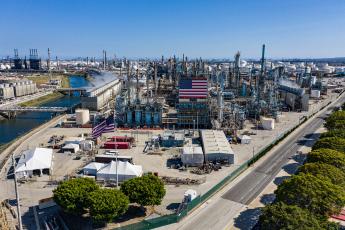Refiners and fuel blenders follow a recipe to produce finished gasoline. The recipes can differ from refinery to refinery depending on the markets they serve and the individual fuel specifications in various states and regions.
One key component called for in nearly every recipe for clean, low-sulfur gasoline is alkylate.
What is alkylate?
Alkylate is high in octane, low in sulfur and has zero aromatics which all help to lower vehicle emissions and tailpipe pollution. Critically, alkylate also has low measures of fuel volatility and evaporative emissions (low Reid Vapor Pressure), a requirement in parts of the country where smog is a concern.
Why do we need alkylate?
There are a number of reasons why refiners view alkylate as essential. Alkylate’s high-octane rating is one of them (alkylate is present in most finished gasoline alongside ethanol, reformate and butane to deliver the necessary fuel octane), but octane is just a small part of what alkylate brings to the table.
Alkylate’s other environmental attributes are what make it irreplaceable. For example:
- There’s no way to meet California demand for reformulated gasoline (CARBOB) without alkylate.
- Low sulfur gasoline rules benefit from alkylate.
- Alkylate is central to manufacturing Clean Air Act Reid Vapor Pressure (RVP)-compliant fuel for parts of the country that fall under those seasonal regulations.
- Internal combustion engine vehicles in the coming years may rely more and more on gasoline that contains alkylate to hit corporate average fuel economy (CAFE) targets for mileage efficiency and carbon reduction.
Where do we get alkylate?
Alkylate is produced at nearly 90% of U.S. refineries in appropriately titled “alkylation units.”
Refineries use different technologies to produce alkylate, depending on their facility configurations and a number of other factors. Today, nearly all alkylate produced in refinery settings is made using one of two catalysts: hydrofluoric acid (HF) and sulfuric acid.
Once a catalyst is chosen and an alkylation unit is constructed around it, the technology cannot just be swapped. It isn’t interchangeable. HF and sulfuric units have completely different designs, footprints and technological requirements.
Why did we start using alkylate in the first place?
The growth of alkylate is tied directly to the United States’ World War II effort. Government backed much of the technological development and buildout of alkylation capacity to supply high-octane aviation gasoline—100 AKI—for WWII combat aircraft.
After the war, demand for alkylation declined and investments in new capacity flatlined. But the 50s brought the motorization of America and with it a need for a lot more gasoline. Additional alkylation capacity and overall U.S. refinery complexity grew from there.
Globally, you can see a similar trend. As more countries motorize, investments in alkylation tend to follow. In fact, IHS Markit projects global demand for alkylate will grow nearly 10% by 2030, and the United States will be critical to satisfying this bigger market.


